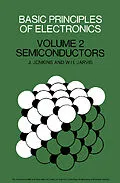Basic Principles of Electronics, Volume 2: Semiconductors focuses on the properties, applications, and characteristics of semiconductors.
The publication first elaborates on conduction in the solid state, conduction and heat, and semiconductors. Discussions focus on extrinsic or impurity semiconductors, electrons and holes, effect of temperature on the conductivity, mean free path, Joule heating effect, "vacancies" in crystals, and Drude's theory of metallic conduction. The text then ponders on semiconductor technology and simple devices, transistor, and transistor production and characteristics. Topics include strain gauges, thermistors, thermoelectric semiconductors, crystal preparation, photoconductors, and the Hall effect.
The book elaborates on special devices, processes, and uses, common transistor circuitry, and a low-frequency equivalent circuit for common base, including radiation detection, optoelectronics, field effect transistors, sonar amplifier, oscillators, and multi-stage amplifiers.
The publication is highly recommended for technical college students and researchers wanting to study semiconductors.
Inhalt
Preface
Chapter 1. Conduction in the Solid State
1.1. Historical
1.2. Vacancies in Crystals
1.3. Drude's Theory of Metallic Conduction
1.4. The Paradox
1.5. Mean Free Time
Chapter 2. Conduction and Heat
2.1. Some Kinetic Theory
2.2. The Mean Free Path
2.3. The Joule Heating Effect
2.4. The Failure of Drude's Theory
2.5. The Work of Wien
2.6. The Modern Picture of Resistivity
2.7. The Effect of Temperature on the Conductivity (E1)
Chapter 3. Semiconductors
3.1. Historical
3.2. Classification of Materials
3.3. Electrons and Holes
3.4. Extrinsic or Impurity Semiconductors
Chapter 4. Semiconductor Technology and Simple Devices
4.1. Terminology
4.2. Crystal Preparation
4.3. The Materials in Use
4.4. Photoconductors (E1)
4.5. The Hall Effect; Magnetometers (E3)
4.6. Thermoelectric Semiconductors (E2)
4.7. Thermistors (E3)
4.8. Strain Gauges (E4)
Chapter 5. The p-n Junction
5.1. Semiconductor Junctions
5.2. Diffusion in a Semiconductor
5.3. The Potential Barrier
5.4. The p-n Junction with Forward and Reverse Bias (E1)
5.5. The Resistance of a p-n Junction
Chapter 6. p-n Junction Devices
6.1. Practical Junctions
6.1.1. The Alloy Junction
6.1.2. The Diffused Junction
6.1.3. Epitaxial Junctions
6.2. Rectifiers (E1)
6.3. Diodes
6.3.1. The Point-Contact Diode
6.3.2. The Gold-Bonded Diode
6.3.3. The Junction Diode
6.4. Comparison of p-n Junction Diodes with Thermionic Valve Diodes
6.5. The Varactor Diode
6.6. The Zener Diode (E3)
6.7. Photocells (E2)
Chapter 7. The Transistor
7.1. The Principle of the Junction Transistor
7.2. The Current Gain, a
Chapter 8. Transistor Production and Characteristics
8.1. Transistor Production
8.1.1. The Germanium Alloy Transistor
8.1.2. The Silicon Alloy Transistor
8.1.3. The Germanium Alloy Power Transistor
8.1.4. The Germanium Diffused Mesa Transistor
8.1.5. The Silicon Diffused Mesa Transistor
8.1.6. The Silicon Epitaxial Planar Transistor
8.2. Transistor Characteristics
8.2.1. Common Base Characteristics (E1)
8.2.2. Common Emitter Characteristics (E2)
Chapter 9. The Transistor as a Circuit Element
9.1. A Low-Frequency Equivalent Circuit for Common Base
9.2. Amplification in Common Base Connection (E1)
9.3. A Low-Frequency Equivalent Circuit for Common Emitter
9.4. The Common Emitter Amplifier (E2)
9.4.1. The Input Resistance, Rin
9.4.2. The Current Amplification, A1
9.4.3. The Voltage Amplification, Av
9.4.4. The Power Amplification, Ap
9.4.5. The Output Resistance, Rout
9.5. Determination of Parameters from Transistor Characteristics (E3)
9.6. The Load Line
9.7. Bias Circuits
9.7.1. Fixed Bias
9.7.2. Self Bias
9.7.3. Stabilized Bias
9.8. Design of a Bias Circuit
9.9. Alternative Transistor Configurations
Chapter 10. Common Transistor Circuitry
10.1. Multi-Stage Amplifiers
10.2. Power Output Stages
10.2.1. Single-Ended Power Output Stages
10.2.2. Double-Ended Power Output Stages
10.2.3. Thermal Runaway; Precautions
10.3. Tuned Amplifiers
10.3.1. Single Tuned Amplifier Stage
10.3.2. Double Tuned Amplifier Stage
10.4. Oscillators
10.4.1. Sinusoidal Oscillators (E2)
10.4.2. Relaxation Oscillators
10.5. The Transistor Switch (E1)
10.5.1. Logic Circuits
10.6. D.C. Amplifiers
10.6.1. Directly-Coupled Circuits
10.6.2. Chopper Circuits
10.7. Inverters
Chapter 11. Special Devices, Processes and Uses
11.1. Heterojunctions
11.2. Sonar Amplifier
11.3. Radiation Detection
11.4. Power Control (E1)
11.4.1. The Thyristor (E2)
11.5. Microwave Devices
11.6. Opto-Electronics (E3)
11.6.1. Light Emitting Diodes
11.6.2. The Laser
11.6.3. Optical Transistor
11.6.4. Electroluminescence
11.6.5. The Phototransistor (E4)
11.6.6. Photo-Avalanche Diode
11.6.7. Heterojunctions
11.7. The Unijunction (E5)
11.8. Field Effect Transistors
11.8.1. The Junction Fet
11.8.2. The Insulated Gate Fet or Metal-Oxide-Semiconductor Transistor (MOST)
11.9. Microelectronics (E7)
Appendixes
I. The h-Parameters
II. Relationship Between h and T Parameters for Common Emitter Configuration
III. Input and Output Resistances and Gains for Grounded Emitter Transistor, in Terms of h-Parameters
IV. Classification of Semiconductor Types
V. Practical Precautions with Transistors
VI. Symbols Used in the Text
VII. Impurity Semiconductors
Index
